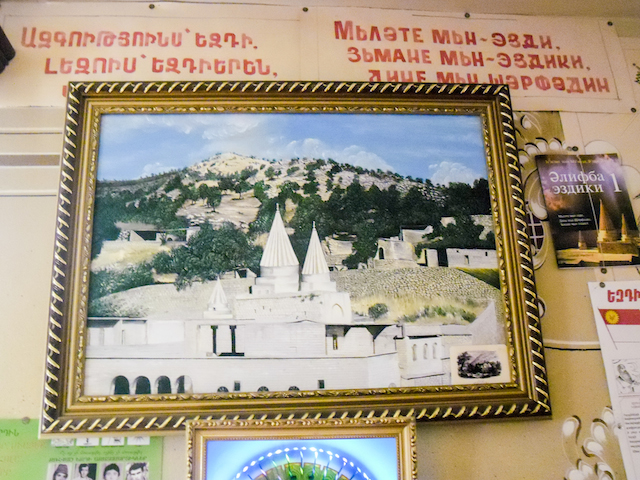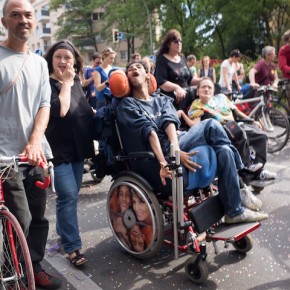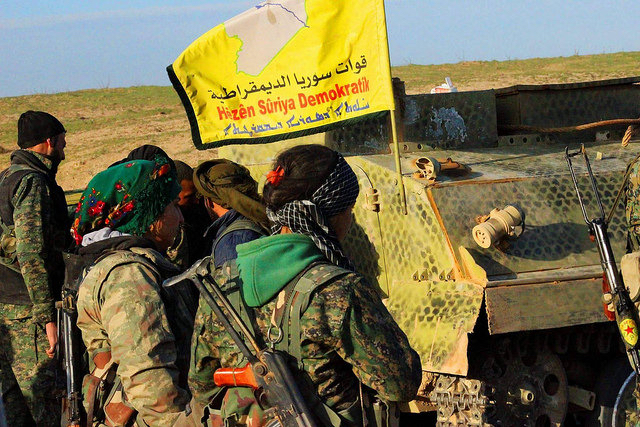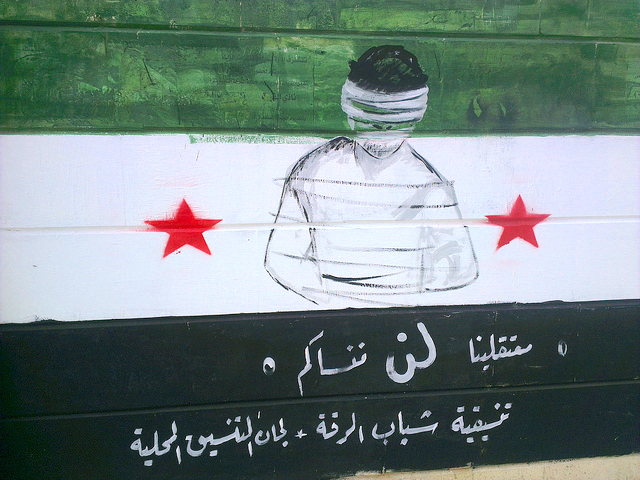“My nation is Yezidi, my language is Ezdiki, my religion is Sherfedin” reads a poster in Cyrillic script on the wall of a Yezidi family home in Zovuni, a village on the outskirts of Armenia’s capital of Yerevan. A portrait of the tomb of Sheikh Adi in Lalish, northern Iraq – a major pilgrimage site for Yezidis – hung on the wall beneath it. The south Caucasus Republic is home to some 40,000 Yezidis – the country’s largest ethnic minority – who are concentrated in the country’s northwestern Aragatsotn province. The massacre of Yezidis in northern Iraq by ISIS forces has bought international attention to the community’s existence – however tentative that may be. Vian Dakhil cannot be forgotten.
The hook used by much of the English-speaking media has been the Yezidis’ syncretic religious beliefs, combining elements of Christianity, Sufi Islam and Zoroastrianism. The ‘secrecy’ and ‘mysteriousness’ have become as symbolic of Iraq’s murdered Yezidis in the public imagination as ‘Christ’s language’ has of the Assyrians (more commonly referred to as ‘other minorities’).
Western writing on Yezidi religious practices will inevitably refer to the misconception of their ‘devil worship’ – one shared famously, but not exclusively, by European orientalists of the nineteenth century. “I was very relieved by the explanation,” wrote Pushkin in 1829 on questioning a Yezidi elder as to his people’s beliefs “and was happy for the Yezidis that they do not worship Satan – their delusions now seem to me much more forgivable.” It is a mistaken belief is indulged all too readily.
Following the withdrawal of Kurdish Peshmerga, the Islamic State’s massacre of Iraqi Yezidis has prompted humanitarian intervention – and US airstrikes. “My dream,” said one friend, a Yezidi activist “is for an autonomous Ezdistan in northern Iraq.” It is a statement I’ve heard several times before, in various accents, moods and volumes from members of Armenia’s Assyrian community – and in the nightmare unfolding in Iraq, it may remain just a dream.
Armenia was an atypical place to get acquainted with a Yezidi community, though perhaps the most appropriate one. Armenia’s Yezidi community organisation, led by Aziz Tamoyan considers them a separate ethnic group, as opposed to many in other countries who simply consider themselves Kurds of a different religious tradition. As the centenary of the Armenian Genocide approaches, Yezidis in the country stress that their community suffered much the same fate as ethnic Armenians and Assyrians in 1915 – at the hands of, among others, Muslim Kurds.

That most of Armenia’s few Muslim Kurds fled to neighbouring Azerbaijan during the Nagorno-Karabakh War is of some relevance, and modern Armenia’s approach towards its ethnic minorities on some level stresses a shared, collective trauma from the final, dying years of the Ottoman Empire. It’s a narrative which echoes throughout Armenian attitudes to the country’s ethnic minority – that on some level, the Republic of Armenia is a nation-state not only of the Armenians, but of all non-Muslim minorities who suffered alongside them in those years.
“They bled for us,” remarked an Armenian friend of the Yezidis, “and that is all I need to say.” Armenia’s Yezidis stake all the claims to ethnic distinctiveness – their language, whilst mutually intelligible with the Kurmanji Kurdish spoken in southern Turkey, is written in a modified version of the Cyrillic script instead of Kurmanji’s Latin. They have staked that claim in stone, in commemorating Yezidi military leader Jahangir Agha who fought alongside Armenian forces against the Turks in 1918.
At a festival of traditional music and dance of Armenia’s minorities held in Yerevan in October 2013, Assyrian, Georgian, Greek, and Yezidi flags flew on Spendaryan Square. The country’s small self-identifying Kurdish community was in attendance – as was its PKK flag. As the music blared, a PKK and Yezidi flags inched higher in mute, passive-aggressive rivalry. The Yezidi community, more numerous, proved successful, a Yezidi student lifting his friend up on his shoulders. This Yezidi identity battle – for it cannot be called a crisis – is a distinctive marker of the Yezidis of Armenia. Yet with the beleaguered Yezidis of Iraq putting their hope in the Kurdish Peshmerga, some have wondered whether old rivalries can withstand urgent calls for unity.
Armenia has been understandably receptive to the attempted genocide of the co-religionists of its largest ethnic minority. Its own historical experience, the shelling of the Armenian town Kessab in Syria, and the recent mass influx of Syrian-Armenians to the Republic, raise the ghosts of the past. Following protests by the Yezidi community in Yerevan, the Armenian government has offered humanitarian aid to Yezidis in Iraq, and there are proposals for a mass resettlement of Yezidis in the disputed territory and self-declared Republic of Nagorno-Karabakh.
The villages of mountainous Aragatsotn Province are home to most of Armenia’s Yezidis, who rely mostly on livestock herding – a pattern of seasonal migration which has its impact on the education of Yezidi children in rural areas, compounding many of the unfortunate stereotypes about the community which still persist in Armenia. The village of Rya Taza is known for its Yezidi cemetery, where three carved statues of horses stand frozen, anchored in the low, windswept grass – a fitting testament to a nomadic history and secretive faith. A more modern Yezidi monument is Ziarat, Armenia’s first purpose-built temple for the community in the village of Aknalich.
Built in 2012 beside an older Yezidi cemetery and seminary of sorts (currently under construction), its cupola modelled on that of the sanctuary at Lalish, in northern Iraq. Within are a painting and replica model of the holy site on a marble altar, where today thousands of Yezidi refugees seek refuge from the Islamic State. “I was surprised when I first heard,” noted Vardan Ascatrian, Armenia’s Presidential adviser for minority affairs, when I interviewed him in November 2013. Many Yezidi communities outside their homeland, he added, have not to his knowledge traditionally constructed such permanent places of prayer. “It is [among other things] for them to understand us better” remarked my Yezidi friend after some introspection, and a form of genuflection towards Lalish.
“The Armenian Genocide ended” observe the country’s Assyrian community when discussing the fate of Assyrians in Iraq “yet the Assyrian genocide still continues.” The Yezidi community must now share the same sentiment – whether written in Cyrillic or in Latin.
Perhaps Ziarat is a symbolic gesture. Misinformation about the Yezidi faith abounds; a marble temple, with more concrete ideas, is something tangible – a small Lalish – so close but yet so far from Iraq – certainly is. A temple is a religious statement that can be recognised as such, if not fully understood. “They pray to the sun,” remarked an Armenian colleague. “No, they pray to a peacock,” interjected her friend. Perhaps we keep the mysteries alive so that the tragedies are easier.
Photographs courtesy of the author






